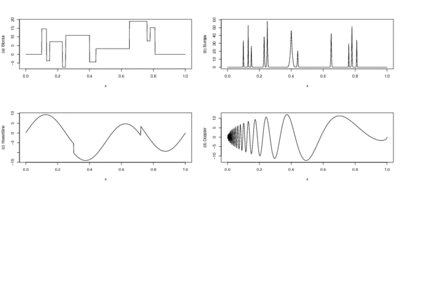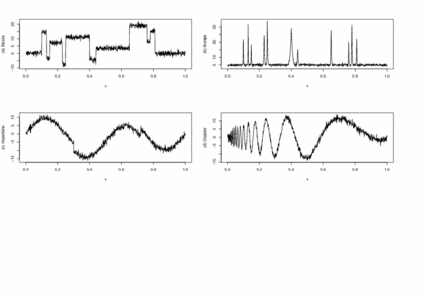WaveThresh
Help
DJ.EX
Produce Donoho and Johnstone test functions
DESCRIPTION
Function to produce the blocks, bumps, Doppler and heavisine functions
described by Donoho and Johnstone (1994).
USAGE
DJ.EX(n=1024, signal=7, rsnr=7, noisy=F, plotfn=F)
REQUIRED ARGUMENTS
None.
OPTIONAL ARGUMENTS
- n
- Number of samples of the function required.
- signal
- A factor that multiples the function values.
- rsnr
- If Gaussian noise is to be added to the functions then this
argument specifies the root signal to noise ratio.
- noisy
- If T then Gaussian noise is added to the signal so that the
root signal to noise ratio is rsnr. If F then just the signals are returned.
- plotfn
- If T then a plot is produced. If F no plot is produced.
-
VALUE
A list with four components: blocks, bumps, heavi and doppler containing
the sampled signal values for the four types of Donoho and Johnstone
test functions. Each of these are deemed to be
sampled on an equally spaced grid from
0 to 1.
SIDE EFFECTS
If plotfn is true then a plot of the four test functions is produced.
DETAILS
The Donoho and Johnstone test functions were designed to reproduce
various features to be found in real world signals such as jump discontinuities
(blocks), spikes (the NMR-like bumps), varying frequency behaviour (Doppler)
and jumps/spikes in smooth signals (heavisine).
These functions are most often used for testing wavelet shrinkage
methods and comparing them to other nonparametric regression techniques.
Another popular function for this purpose is the
Piecewise Polynomial created
in Nason and Silverman (1994)
NOTE: This function might not give exactly the same function values
as the equivalent function in WaveLab
RELEASE
Copyright Theofanis Sapatinas. Help by Guy Nason 2004
SEE ALSO
example.1,
wd,
threshold.
EXAMPLES
#
# Show a picture of the four test functions with the default args
#
DJ.EX(plotfn=T)
 #
# Show a picture of the noisy test functions with the default args
#
DJ.EX(plotfn=T)
#
# Show a picture of the noisy test functions with the default args
#
DJ.EX(plotfn=T)

 #
# Show a picture of the noisy test functions with the default args
#
DJ.EX(plotfn=T)
#
# Show a picture of the noisy test functions with the default args
#
DJ.EX(plotfn=T)

# # Show a picture of the noisy test functions with the default args # DJ.EX(plotfn=T)
